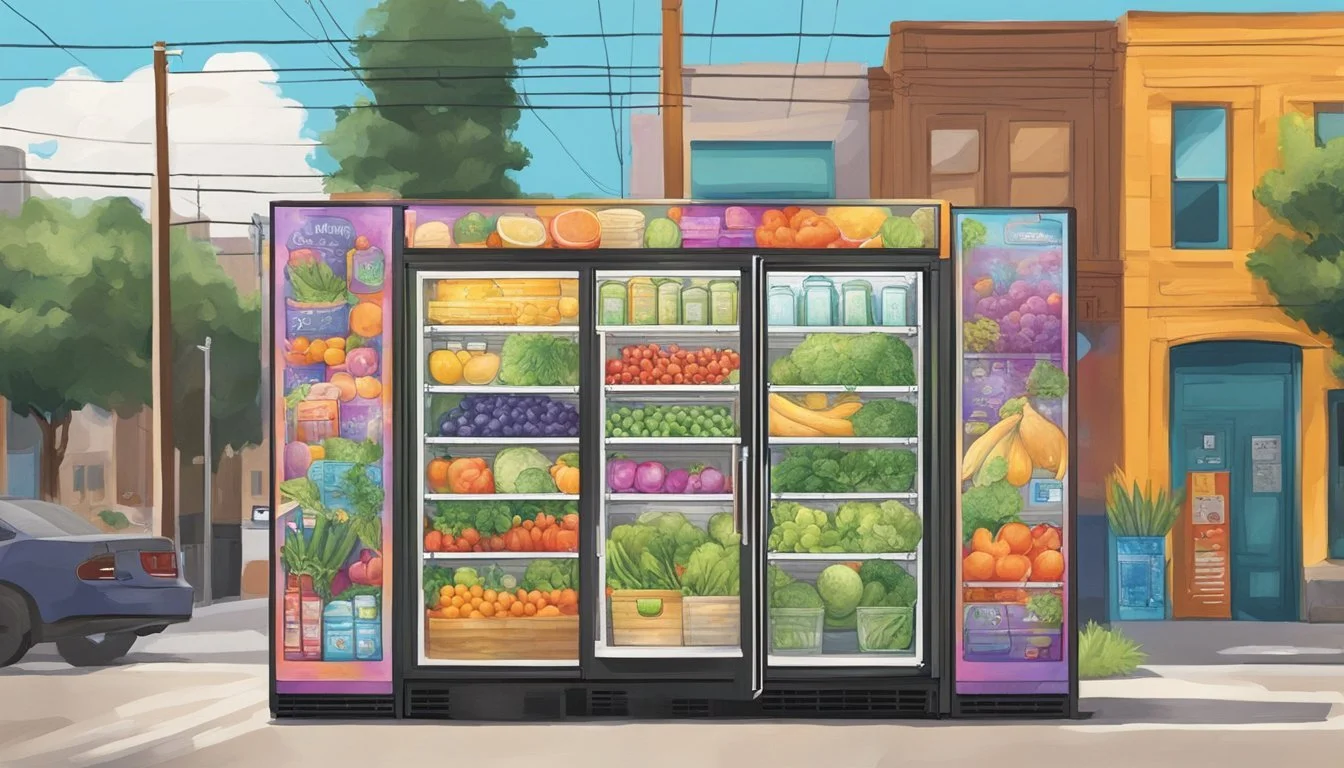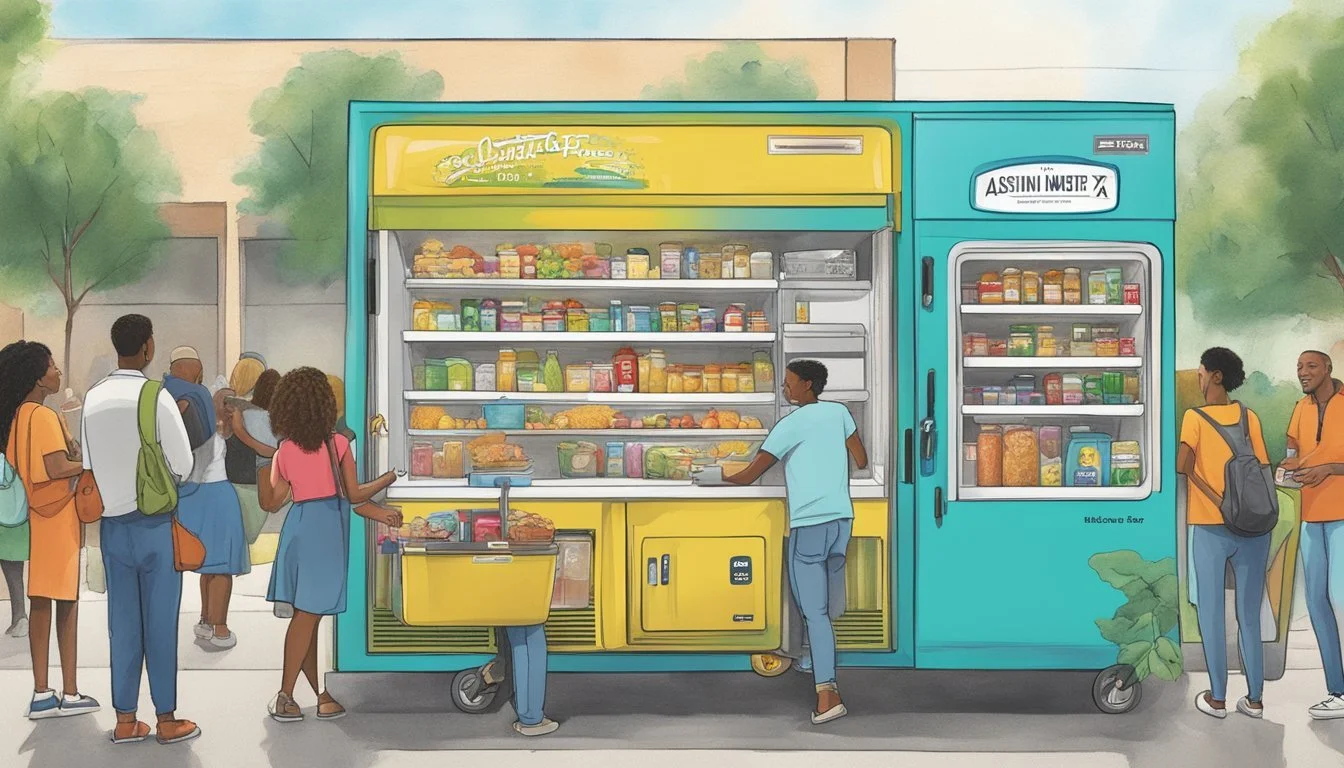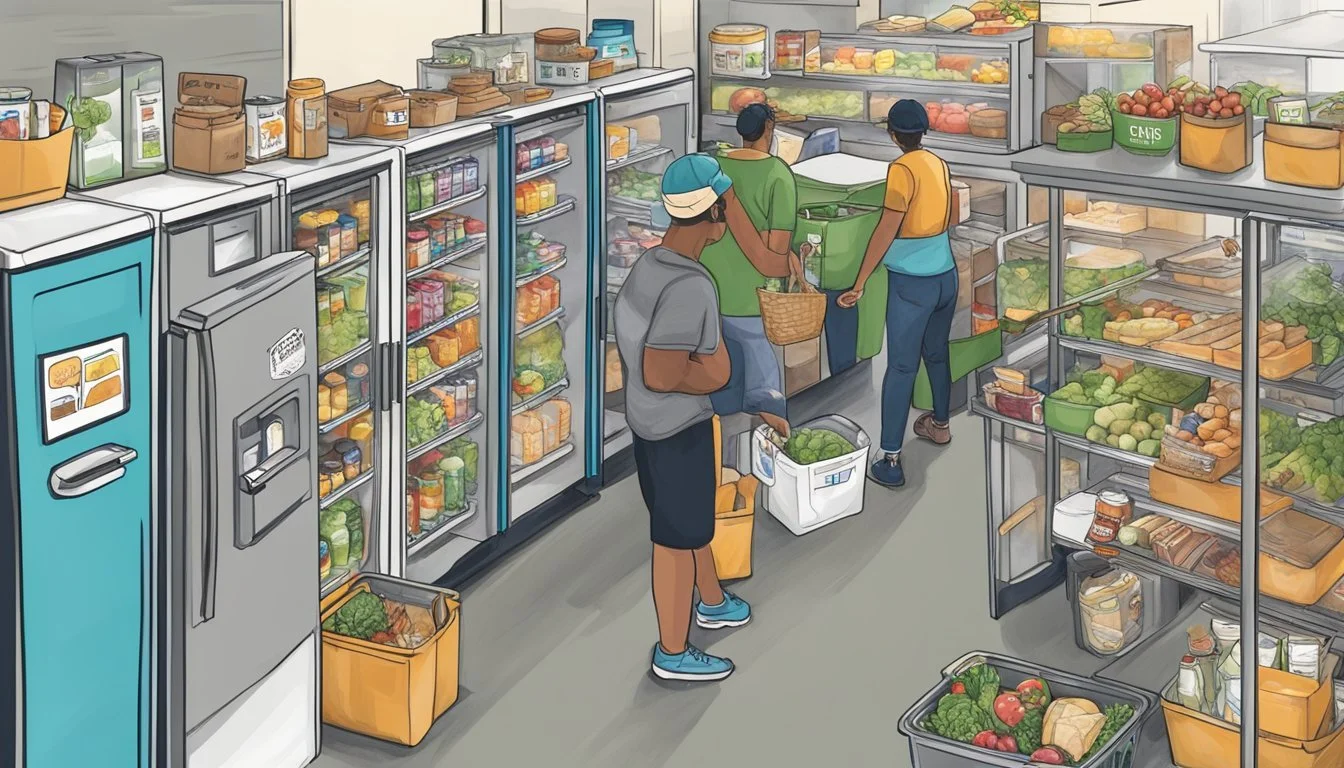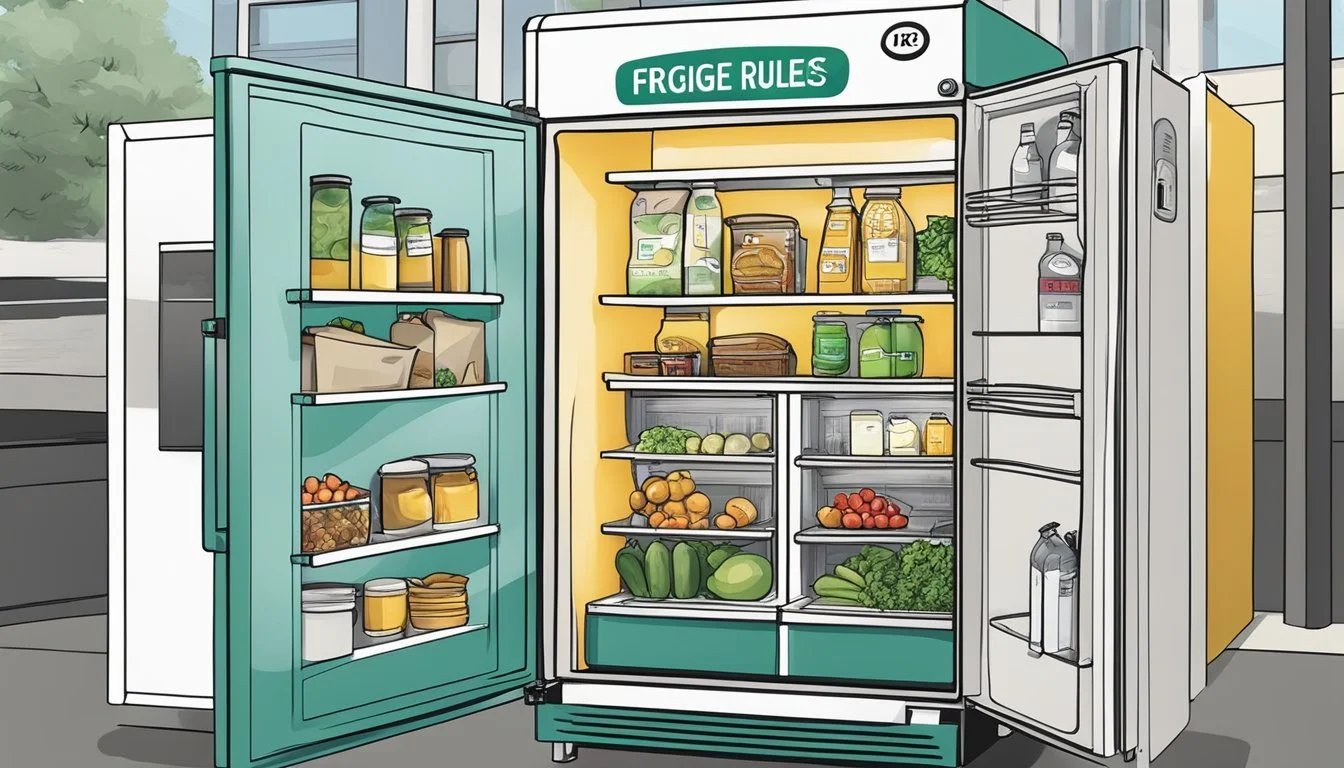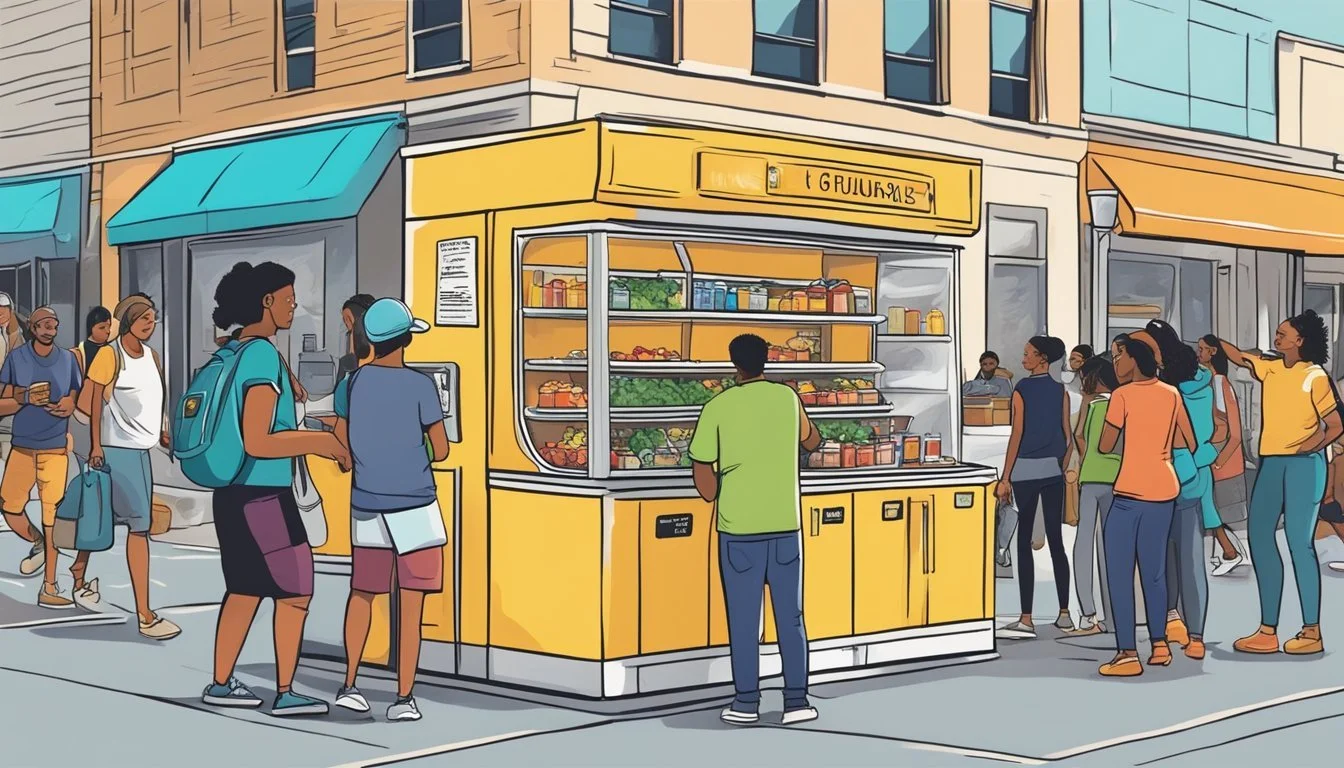Austin, TX Community Fridge Initiative
Addressing Food Insecurity Locally
In Austin, Texas, a novel initiative—the ATX Free Fridge Project—has emerged as a beacon of community support and solidarity. This project targets food insecurity and waste by providing 24/7 access to freely available refrigerators filled with food around the city. These community fridges represent more than just a place where people can find a meal; they stand as a symbol of neighborly care and a collective effort to provide for those facing hardship.
The first fridge was placed at East Austin restaurant Nixta Taqueria during the summer, kicking off the ongoing project that encourages local participation. Painted by artist Enda M. Brennan, it not only offers sustenance to those who need it but also acts as a canvas that reflects the community's creativity and commitment to mutual aid. The founding principle of the project—solidarity, not charity—underscores its approach, where everyone is welcome to contribute food and help maintain the fridges, thus fostering a sense of involvement and ownership within the community.
Navigating through the pandemic and its economic challenges has highlighted the importance of initiatives like the ATX Free Fridge Project. The fridges serve as a critical resource in food-insecure neighborhoods, offering a grassroots solution to a widespread problem. They act as a testament to Austin's community spirit, where a simple act of sharing resources translates into a stronger, more resilient urban fabric.
Origin of Austin's Community Fridge Movement
The genesis of Austin's Community Fridge Movement can be traced back to a time of heightened need and community spirit during the COVID-19 pandemic. It is a shining example of local ingenuity and compassion addressing food insecurity.
Pandemic Response
In response to the challenges posed by the COVID-19 pandemic, Austin, Texas saw the emergence of the ATX Free Fridge Project to tackle increasing food insecurity. The pandemic era heightened the community's awareness about the struggles faced by many of its members, leading to a solidarity-driven approach to aid those in need. This was not just a response to a public health crisis; rather, it was a profound statement of community support.
Local Initiatives
The pioneering local initiative of Austin's community fridge was spearheaded by the ATX Free Fridge Project, which positioned its first fridge outside Nixta Taqueria in East Austin. The fridge, painted by local artist Enda M. Brennan, served as a symbol of community support and unity. The initiative operates under the ethos of "solidarity, not charity," reflecting a community-centric approach to philanthropy. Local support continues to be pivotal for the sustainability of the movement, with efforts focusing on mutual aid and the reduction of food waste.
Community Fridge Locations and Operations
In Austin, Texas, community fridge programs serve as a nexus for food solidarity, offering free access to food and a way to combat waste. These programs operate at various locations, bringing tangible benefits to the vicinity.
Nixta Taqueria Spot
Nixta Taqueria, located in East Austin, marked the beginning of the ATX Free Fridge Project. It houses a refrigerator where community members have access to food at no cost. This initiative launched on July 20 and functions as an exemplar for future expansions.
East Austin Center
East Austin acts as the focal point for the ATX Free Fridge Project, where it aims to alleviate food insecurity. The neighborhood's investment in community fridges underscores a significant step towards addressing the needs of local residents through direct and immediate solutions.
Expansion to Other Areas
The ATX Free Fridge Project is set on extending its reach beyond its initial locations. Efforts are being made to pinpoint new areas within Austin for possible future expansion, aiming to erect additional refrigerators and thus broaden the program's impact on fighting food insecurity across the city.
Involvement and Impact
The Austin Community Fridge initiative thrives on robust community participation and inter-organizational cooperation, fostering food security and acting as a vehicle for neighborhood solidarity.
Community Support
Community involvement forms the backbone of the Community Fridge program in Austin. Residents contribute by stocking the fridges with a diverse range of food options that include vegetables, fruits, breads, and prepared foods. The program operates on a principle of solidarity, reinforcing the call to action for community members to donate food and volunteer for fridge cleaning.
Business and Artist Contributions
Local businesses and artists contribute significantly to the fridges' success. Business entities often offer financial support or donate surplus food, while local artists sometimes beautify the fridges, increasing visibility and public engagement. Through these contributions, there is a synergy between economic support and cultural expression, strengthening community bonds.
Food Banks Collaboration
The Community Fridge program collaborates with established food assistance organizations like food banks to enhance its impact. Coordination with groups like the Sustainable Food Center and area Food Banks ensures a steady flow of donations and adherence to food safety standards. This collaboration helps in maintaining a sustainable supply of food to those who need it, reinforcing the program's foundation of support and solidarity.
Contributing to the Community Fridges
Contributing to community fridges in Austin is a powerful way to address food insecurity, reduce food waste, and support the local community. Here's how individuals can get involved through donations or volunteering.
How to Donate
Location and Accessibility:
Community Fridges: Typically available 24/7 for drop-offs.
Specific Locations: Check fridge sites for addresses and hours, such as the ATX Free Fridge Project at locations like Nixta Taqueria.
Best Practices:
Ensure that food donations are safe, unexpired, and comply with community guidelines.
Keep food donations in their original packaging when possible.
What to Donate
Ideal Donations Include:
Groceries: Fresh fruits, vegetables, bread, and non-perishable items.
Prepared Meals: Ensure they are freshly made, packaged properly, and labeled with ingredients.
Canned Goods: Such as soups and vegetables—preferably with easy-open tabs.
Eggs and Milk: High-demand items that should be fresh and kept in proper temperature conditions.
Dietary Restrictions: Consider gluten-free, nut-free, and dairy-free items to cater to those with allergies.
Donation Checklist:
Non-perishable pantry items
Fresh produce
Sealed prepared meals
Dietary restriction-friendly foods
Volunteer Opportunities
Roles for Volunteers:
Fridge Maintenance: Cleaning and organizing the fridge spaces.
Food Collection: Gathering food from donors or businesses.
Food Distribution: Ensuring the equitable distribution of food items.
How to Get Involved:
Contact the ATX Free Fridge Project or other local community fridge initiatives to register as a volunteer.
Volunteer training is typically provided to ensure safety and adherence to health guidelines.
Food Security and Sustainability
In Austin, Texas, community initiatives such as the ATX Free Fridge Project have taken a dual approach to address the pressing issues of food insecurity while also promoting environmental sustainability through the reduction of food waste.
Tackling Food Insecurity
The ATX Free Fridge Project contributes to food security in Austin by providing 24/7 access to stocked community refrigerators. These fridges are filled with fresh produce and other food items, making them accessible to those who face barriers in obtaining sufficient, safe, and nutritious food—characteristics typical of food deserts. Unlike traditional charity, the framework of mutual aid driving this project empowers community members to take part in addressing their own needs collectively.
Reducing Food Waste
By encouraging residents to donate surplus food, Austin's community fridges help reduce food waste significantly. These donations might include items that would otherwise be discarded, effectively diverting them from landfills where they would contribute to greenhouse gas emissions. This proactive step not only alleviates hunger but addresses the larger issue of waste in the food supply chain.
Promoting Sustainable Practices
Organizations like the Sustainable Food Center in Austin focus on strengthening the local food system. The goal is not only to provide immediate access to food but also to promote long-term sustainability by supporting local agriculture and reducing the carbon footprint associated with long-distance food transport. These practices are pivotal in creating a more resilient and environmentally conscious food ecosystem in the city.
Safety and Guidelines
The Austin Community Fridge initiative strives to provide food to those in need while ensuring the health and safety of the community. Attention to proper food handling, contamination prevention, and allergy awareness is critical to the success of the program.
Proper Food Handling
To maintain food safety, individuals should follow specific guidelines when handling fresh produce and raw meat. Fresh produce should be thoroughly washed and dried before being placed in the community fridge. When donating raw meat, it is imperative to ensure it's fresh and kept at a safe temperature during transport. Donors should use sealed containers or secure packaging to prevent any leakage.
Fresh Produce: Wash, dry, and place in clean containers.
Raw Meat: Fresh, cold, and securely packaged.
Avoiding Contamination
Contamination can pose a serious risk to food safety. Donors are advised to clean their hands, surfaces, and utensils before handling food meant for donation. Separation of different food types, especially raw meat from other items, is necessary to prevent cross-contamination.
Best Practices to Avoid Contamination:
Always wash hands before handling food.
Keep raw meat separate from other foods.
Use clean containers and packaging materials.
Allergy Awareness
The community fridge serves a diverse population, including those with dietary restrictions and allergies. Contributors are encouraged to label donated food items clearly, specifying if they contain common allergens like nuts, gluten, dairy, or eggs.
Labeling for Allergies: Clearly mark allergens on food packages.
Dietary Restrictions: Provide variety to accommodate different diets.
By adhering to these safety guidelines, Austin's Community Fridge program can help ensure that everyone has access to safe and nourishing food while minimizing health risks.
Community Engagement and Education
The Austin Community Fridge initiative thrives on active engagement and education to ensure its sustainable impact on food insecurity. Programs and partnerships are crafted with a focus on resource-sharing and educating the public on the significance of community solidarity and support.
Outreach Programs
Outreach programs play a crucial role in expanding the reach and effectiveness of Austin's community fridge efforts. Through Instagram and other social media platforms, the initiative educates and engages the local community. These platforms serve not just as informational resources but also as tools to foster community solidarity. They highlight the availability of community fridges and encourage the involvement of volunteers and donors.
Partnerships with Educational Institutions
The initiative has forged partnerships with educational institutions to instill values of community support and to educate students about food insecurity. These partnerships often result in:
Resource development: creating educational material and programs;
Food Donations: schools may organize food drives to support the fridges;
Volunteer Opportunities: students and staff participate in maintaining and stocking the fridges.
By integrating the community fridge project into educational settings, students are provided with hands-on learning experiences about community solidarity and the power of collective action.
Media, Recognition, and Future Outlook
As the Austin Free Fridge Project (AFFP) evolves, media outlets have spotlighted the initiative, recognition has been earned by its founders, and anticipations for growth have been formed.
Press Coverage
The local community initiative has garnered attention from various publications, highlighting its efforts in food insecurity and sustainability. The AFFP gained visibility through Eater Austin, particularly when the project placed its inaugural fridge at Nixta Taqueria. Moreover, the initiative's partnership for water stations and PPE has been noted by sources like Austin Mutual Aid, indicating a broadening scope in community service.
Highlighted Articles:
"Austin Gets Its First Community Fridge Program - Eater Austin"
"Community fridges don't just fight hunger. They're also a climate..." — no specified outlet
Awards and Acknowledgements
Edgar Rico and Sara Mardanbigi, the proprietors of Nixta Taqueria, have been dubbed local heroes, as reported on January 14, 2024, by Good News Network. Their selfless contributions through the community fridge outside their establishment earned them public admiration and potentially, further awards.
Future Plans for the Project
The AFFP is actively planning to expand, with the second community fridge location announced to be situated outside the herbal store Earth Commons in East Austin. This reflects a commitment to a scalable framework, reminiscent of previous movements such as those in New York by organizations like In Our Hearts NYC based in Brooklyn.
Upcoming Locations:
East Austin: Earth Commons
Additional neighborhoods (TBD)
Kyandra Noble and Lindsay Gallagher, key members of the AFFP team, are determined to broaden the project's reach within Texas, continuing the mission of Solidarity not charity. Engagement through Instagram, Email, and the official Website ensures the community is informed and involved.
Get Involved
To support Austin's fight against food insecurity, individuals are encouraged to connect with local community fridge initiatives and contribute positively. Below are specific methods to get involved, including contact details and social media platforms.
Contact Information
ATX Free Fridge Project is always in need of volunteers who can contribute their time and effort. Interested individuals can reach out via email for more details on how to get involved.
This email can be used to inquire about volunteer opportunities, food donations, and to get guidance on starting a new community fridge.
Social Media and Updates
Keeping up-to-date with the latest news, locations, and needs is crucial for efficiently supporting community fridges. The ATX Free Fridge Project maintains an active presence on Instagram, offering regular updates and engaging with the community.
Instagram: @atxfreefridge
Through this platform, they share important announcements, such as the availability of food items, cleaning schedules, and locations of newer fridges. Volunteers and the community are encouraged to follow to stay up-to-date.
Support and Sponsorship
The Austin, TX Community Fridge programs thrive on collaborative efforts and financial backing from various entities. These chill hubs of nutrition and care are not just appliances but symbols of community support and solidarity against food insecurity.
Partnership Opportunities
Community fridges in Austin have flourished thanks to partnerships with local businesses, including restaurants and herbal stores, which provide spaces to host these vital resources. These businesses not only contribute in terms of location but also often provide essential supplies to ensure the fridges are stocked. Expansion efforts are underway as the programs seek new locations and business partners for the upcoming year, aiming to further increase the reach of this community support system.
Financial Contributions
The sustainability of community fridges is largely funded through donations by individuals and organizations. These contributions are essential for the ongoing provision of fresh and nutritious food, available 24/7. The Austin Free Fridge Project (AFFP), for instance, encourages both one-time and recurring financial support through various platforms. Potential donors can often contribute with options starting as low as $1 USD, demonstrating that every contribution, no matter the size, is invaluable.
Contribution Type Benefit to Community Fridge One-Time Donation Helps maintain current fridge operations and stock Recurring Donation Supports the long-term sustainability of the fridges
As these community support mechanisms continue to develop, they embody the collective investment in the well-being of Austin's residents, proving solidarity is indeed more impactful than charity.

